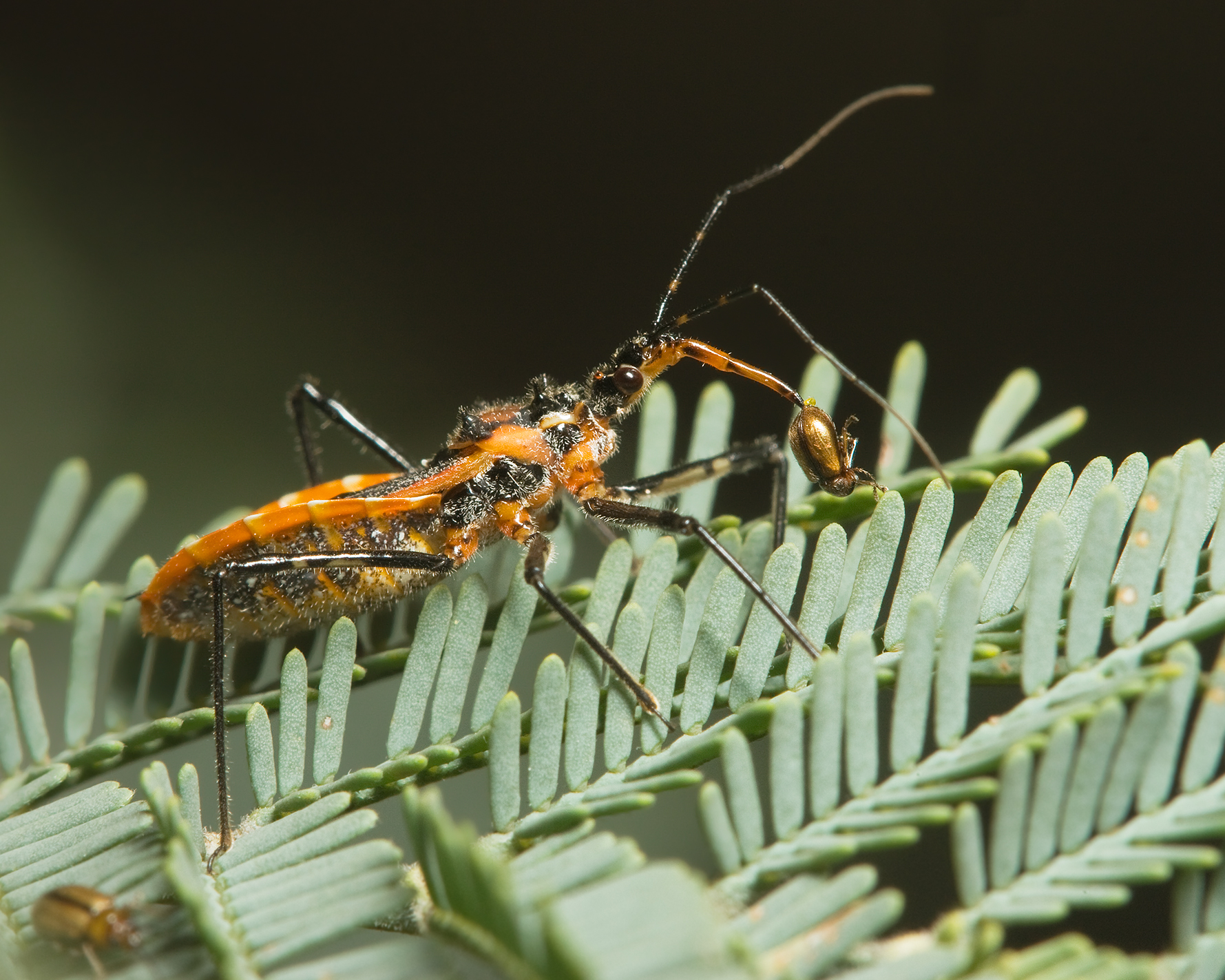|
Ectrichodiinae
The Ectrichodiinae are a subfamily of assassin bugs (Reduviidae) known for specializing on millipedes as prey. The group comprises more than 600 species in about 115 genera, making it a fairly large subfamily. The bugs are also known for their aposematic coloration, often brightly colored metallic blue, red, or yellow. Species of this subfamily hide under leaf litter and sometimes boulders and hunt at night. Females have wing reduction and or/ extreme sexual dimorphism. Genera The following genera are recognised in the subfamily Ectrichodiinae: ;Tribe Abelocephalini Forthman and Weirauch, 2017 *''Abelocephala'' Maldonado, 1996 *''Afrodecius'' Jeannel, 1919 *''Apocaucus'' Distant, 1909 *''Enigmocephala'' Rédei, 2007 *''Gastrogyrus'' Bergroth, 1921 *''Homognetus'' Bergroth, 1923 *''Matangocoris'' Miller, 1940 *''Megapocaucus'' Miller, 1954 ;Tribe Ectrichodiini Amyot and Serville, 1843 *''Adrania'' Stål, 1863 *''Afrocastra'' Breddin, 1903 *''Antiopula'' Bergroth, 1863 ... [...More Info...] [...Related Items...] OR: [Wikipedia] [Google] [Baidu] |
Brontostoma
''Brontostoma'' is a neotropical genus of assassin bugs in the family Reduviidae. About 20 species have been described. These species are brightly colored with reds and oranges, and like all members of the Ectrichodiinae, specialize on millipede prey. Partial list of species *''Brontostoma bahiensis'' Gil-Santana 2004 *''Brontostoma deferreri'' *''Brontostoma discus'' Burmeister, 1835 *''Brontostoma diringshofeni'' *''Brontostoma notatum'' *''Brontostoma rubrum'' *''Brontostoma sanguinosum'' Stål, 1872 *''Brontostoma trux'' References {{Taxonbar, from=Q4974109 Reduviidae ... [...More Info...] [...Related Items...] OR: [Wikipedia] [Google] [Baidu] |
Caecina (bug)
''Caecina'' is a genus in the subfamily Ectrichodiinae of Reduviidae The Reduviidae is a large Cosmopolitan distribution, cosmopolitan family of the suborder Heteroptera of the Order (biology), order Hemiptera (true bugs). Among the Hemiptera and together with the Nabidae almost all species are terrestrial ambush ... (assassin bugs); 16 species have been described, all of them are located in Eastern Asia. Species * '' Caecina cognata'' Miller, 1955 * '' Caecina consimilis'' Miller, 1941 * '' Caecina intrepida'' Miller, 1941 * '' Caecina javana'' (Breddin, 1903) * '' Caecina javanica'' Maldonado, 1948 * '' Caecina montana'' Miller, 1953 * '' Caecina nubila'' Miller, 1954 * '' Caecina sinica'' Cui, 2008 * '' Caecina spinulosa'' Stål, 1863 * '' Caecina sumatrensis'' Miller, 1941 * '' Caecina venatrix'' Miller, 1948 * '' Caecina venosa'' Miller, 1954 * '' Caecina walshae'' Miller, 1958 References {{Taxonbar, from=Q5016716 Cimicomorpha genera Reduviidae Fauna of East Asi ... [...More Info...] [...Related Items...] OR: [Wikipedia] [Google] [Baidu] |
Austrokatanga
''Austrokatanga monteithi'' is a species of assassin bug, the sole member of its genus, in the subfamily Ectrichodiinae of Reduviidae. This species is found in Australia Australia, officially the Commonwealth of Australia, is a country comprising mainland Australia, the mainland of the Australia (continent), Australian continent, the island of Tasmania and list of islands of Australia, numerous smaller isl .... References {{Taxonbar, from=Q4825658 Reduviidae Hemiptera of Australia ... [...More Info...] [...Related Items...] OR: [Wikipedia] [Google] [Baidu] |
Assassin Bugs
The Reduviidae is a large cosmopolitan family of the suborder Heteroptera of the order Hemiptera (true bugs). Among the Hemiptera and together with the Nabidae almost all species are terrestrial ambush predators; most other predatory Hemiptera are aquatic. The main examples of non-predatory Reduviidae are some blood-sucking ectoparasites in the subfamily Triatominae, with a few species from South America noted for their ability to transmit Chagas disease. Though spectacular exceptions are known, most members of the family are fairly easily recognizable: they have a relatively narrow neck, sturdy build, and formidable curved proboscis (sometimes called a rostrum). Large specimens should be handled with caution, if at all, because they sometimes defend themselves with a very painful stab from the proboscis. Taxonomy The family members are almost all predatory, except for a few blood-sucking species, some of which are important as disease vectors. About 7000 species have been describ ... [...More Info...] [...Related Items...] OR: [Wikipedia] [Google] [Baidu] |
Millipedes
Millipedes (originating from the Latin , "thousand", and , "foot") are a group of arthropods that are characterised by having two pairs of jointed legs on most body segments; they are known scientifically as the class Diplopoda, the name derived from this feature. Each double-legged segment is a result of two single segments fused together. Most millipedes have very elongated cylindrical or flattened bodies with more than 20 segments, while pill millipedes are shorter and can roll into a tight ball. Although the name "millipede" derives from Latin for "thousand feet", no species was known to have 1,000 or more until the discovery in 2020 of '' Eumillipes persephone'', which can have over 1,300 legs. There are approximately 12,000 named species classified into 16 orders and around 140 families, making Diplopoda the largest class of myriapods, an arthropod group which also includes centipedes and other multi-legged creatures. Most millipedes are slow-moving detritivores, eating ... [...More Info...] [...Related Items...] OR: [Wikipedia] [Google] [Baidu] |
Charles Jean-Baptiste Amyot
Charles Jean-Baptiste Amyot (23 September 1799, in Vendreeuv – 13 October 1866, in Paris) was a French lawyer and entomologist especially interested in the Hemiptera. After his father died, Amyot lived with a neighbor, a wealthy merchant, who was also an entomologist, Jean Guillaume Audinet-Serville. They become life-long friends, and Audinet-Serville advised Amyot to specialize in the Hemiptera, which at the time was being ignored by serious entomologists. In 1822, Amyot became a lawyer, but he continued to study the Hemiptera. In 1833, he published a work on civil law, ''Institutes, ou Principes des lois civiles'' (''Institutes, or the principles of civil law''). In 1843, together with Audinet-Serville, he published ''Histoire naturelle des insectes hémiptères'' (''The Natural History of the Hemiptera Insects''). Amyot was also interested in applied entomology and wrote several publications devoted to insect pests and how to fight them. Amyot later became the president o ... [...More Info...] [...Related Items...] OR: [Wikipedia] [Google] [Baidu] |

